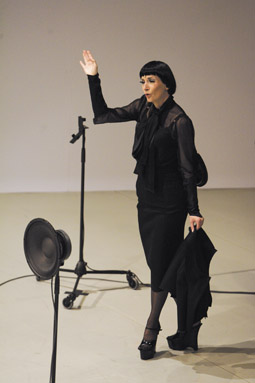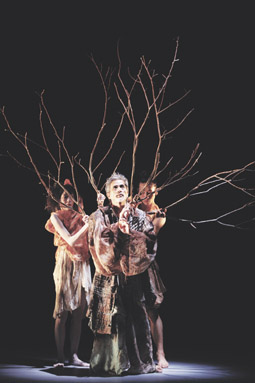 |
Joanna Dudley, The Scorpionfish photo James Knowler |
Consider the allure of do-it-yourself backpacking, with its promise of cultural encounters and its marketing of culture shock. Such authenticity of immersion is denied those who prefer their holidays pre-packaged and their encounters mediated through the windows of a bus. But if in the future opportunities for excursions into foreign lands or the wilderness are to contract, we may come to value more acutely the exotic species in our own gardens, aquariums and zoos—and in those performances which extend an invitation to imaginatively encounter what lies beyond the horizons of the known. Indeed, theatrical performance excels at enabling encounters with the exotic, the unusual, the unfamiliar and the strange in humans and their cultures, and it does so under resource restricted conditions with relative comfort, easy access and minimal distress.
In many respects, this was the invitation of the OzAsia festival, the Adelaide Festival Centre’s inaugural celebration of culture and performance from Asia, Australia and Asian-Australia. OzAsia extended an invitation to encounter cultural difference, and it did so with the promise that we may recognise our own culture anew. However, global flows of culture and performance have created such convoluted mixtures of the familiar and the strange as to confound our certainties.
the scorpionfish
Kroncong, for example, is a kind of pop music from Java. It provides some of the musical score for The Scorpionfish, a piece of music theatre from Joanna Dudley and Rufus Didwiszus which had its premiere performance in Berlin in January. The rhythms, harmonies and instrumentation of kroncong are familiar enough to western ears. Historically, they are derived from fado, the songs sung by the Portuguese who established trading posts in eastern Indonesia in the 16th century.
But Kroncong is a hybrid style of music, a blend of European and Javanese, with a complex social history. Once the preserve of Jakarta’s urban poor, it was adopted by the nationalists in the 1940s as the people’s music and it has remained in nostalgic favour among the Sukarno generation, though younger people came to regard its nationalist associations with suspicion.
In Dudley and Didwiszus’s performance, however, kroncong is radically decontextualised. Its vocal qualities and lyrics, in particular, are thoroughly estranged from time and place. The work’s title is borrowed from Nicolas Bouvier’s book of travels in Sri Lanka. The subtitle, ‘Song and Dance in Tropical Downtown’, is geographically generic. The set–three white walls, white floor, no doors–is stark and post-dramatic.
Dudley, an Anglo-Australian performer originally from Adelaide, transforms herself into the Scorpionfish. An exotic creature from the abstract East, she lives in a tropical aquarium of urban oriental sounds emitted from ominous black speaker cones on stands. The soundscape is impressive: chirping frogs, rain and radio static, gamelan gongs and bird song.
Dudley performs solo, singing and dancing with nervously compelling diva poise. Her costumes form a minimalist suite of Eurasian femmes-fatale: from business style to geometric geisha, cabaret lingerie to Mandarin nightclub. Her European affectation of Asiatic grace is sustained to curtain call. The performance is executed with inscrutable precision, its tone is cute at times, even seductive, but always calculated and sometimes cold.
The Scorpionfish is a performance in the grand orientalist tradition. From the modernists (Craig, Yeats, Brecht and Artaud) to the interculturalists (Grotowski, Barba, Brook and Wilson), western artists have long sought inspiration for stylistic innovation in the performance traditions of Asia. Dudley’s cultural capital as a western artist enabled her to study song and dance in Java. It led to her “becoming embraced as a pop icon in the city of Surakarta”, according to the program.
Yet in The Scorpionfish, Dudley detaches kroncong from its cultural moorings in bodies, time and place. She redeploys it within a European context predetermined by the post-dramatic. In this decontextualising move, The Scorpionfish rendered apparent a latent orientalism propelling interest in OzAsia. I wondered if this work would find an audience in Java.
 |
Leigh Warren & Dancers, Wanderlust photo Hiroyasu Daid |
wanderlust
Wanderlust, a collaboration between Leigh Warren & Dancers and Japanese dancer and choreographer Uno Man, transcends the orientalist attitude. It had its premiere in Japan in October 2006. Participating in that rich and well supported flow of people, culture and performance between Australia and Japan, Wanderlust followed a different path in search of encounters with the strange.
The work is inspired by the celebrated poetry of Matsuo Basho (1644-1694) who cultivated his haiku through an aesthetic practice of attentive wandering. According to philosopher Thomas Heyd, Basho found it difficult to write poetry “while remaining in one place for very long.” Basho’s wandering aimed to estrange him from the familiar and the known. This experience of estrangement he would deploy in poetry to apprehend the nature of the world anew.
Wanderlust is structured like the memory of a journey. It recalls not every step but scenes along the way. The opening scene, ‘Prelude/First Step’, consists of little more than dancers walking, fading in and out of view. From there the scenes unfold. Creatures are encountered as environments are traversed: Cicada, Stone Woman, Boy’s Day/Carp, Small Islands, Paddy Field, Deer and Forest, Waterfall, Hermitage Lantern and Battle Plain.
Alongside Uno Man, the dancers are Deon Hastie and Jo Roads from Australia, Mako Kawano and Tomohiko Tsujimoto from Japan. The choreography is supple, light and precise, rippling from the core to distal joints and arriving at positions with finely tuned decelerations. At times I feel they dance like birds with hollow bones. But where the pleasure of the work emerges is within the choreographic articulation of the environments.
According to Leigh Warren, the developmental process was unusual. Having analysed the dramaturgy of Basho’s texts, they first created environments of light, space and projection, before choreographing the work. The projected animations from visual designer Tetsutoshi Tabata are extraordinarily beautiful. Simple shapes in plain colours are softly projected onto diaphanous screens amongst which dancers move.
As the scenes unfold, the visual effect is dream-like and elusive. Like a journey, it is utterly compelling in the present, yet difficult to remember as a whole. In the final scene, Moon/Last Breath, Uno Man dances with the exhaustion of old age, but also with the sense of an arrival somewhere other than home.
dis-oriental
Yumi Umiumare’s 20-minute solo work, Dis-Oriental, is also motivated by an experience of estrangement, as attended in the work of Japanese architect Shigeru Ban whose emergency houses built from cardboard tubes address the need for comfort when disasters reduce homes to smoking piles of rubble and the familiar is rendered strange.
Toilet rolls, odd shoes and clothes, a book, a birdhouse and a balloon are the objects which Umiumare plays with and displays in this manic meditation on the necessity of comfort and self-care under conditions of estranged duress. Living well among the unfamiliar is a survival strategy for our time.
The Scorpionfish—Song and Dance in Tropical Downtown, created & performed by Joanna Dudley, creation & scenography Rufus Didwiszus, costumes Bernd Skodzig, choreography Nicola Mascia, sound design Dirk Dresselhaus, Space Theatre, Oct 1-2; Wanderlust by Leigh Warren & Dancers in association with Uno Man, direction, choreography Uno Man, Leigh Warren, dancers Uno Man, Mako Kawano, Tomohiko Tsujimoto, Jo Roads, Deon Hastie, visual design, screen media Tetsutoshi Tabata, composer Stuart Day, lighting Nic Mollison, costumes India Flint, Dunstan Playhouse, Oct 3-6; Dis-Oriental, choreographer, performer Yumi Umiumare, sound design Cat Hope, lighting Richard Vabre, Space Theatre, Adelaide Festival Centre, Sept 28-29; OzAsia Festival 2007: for full program see www.ozasiafestival.com.au
RealTime issue #82 Dec-Jan 2007 pg. 13
© Jonathan Bollen; for permission to reproduce apply to [email protected]








 back
back